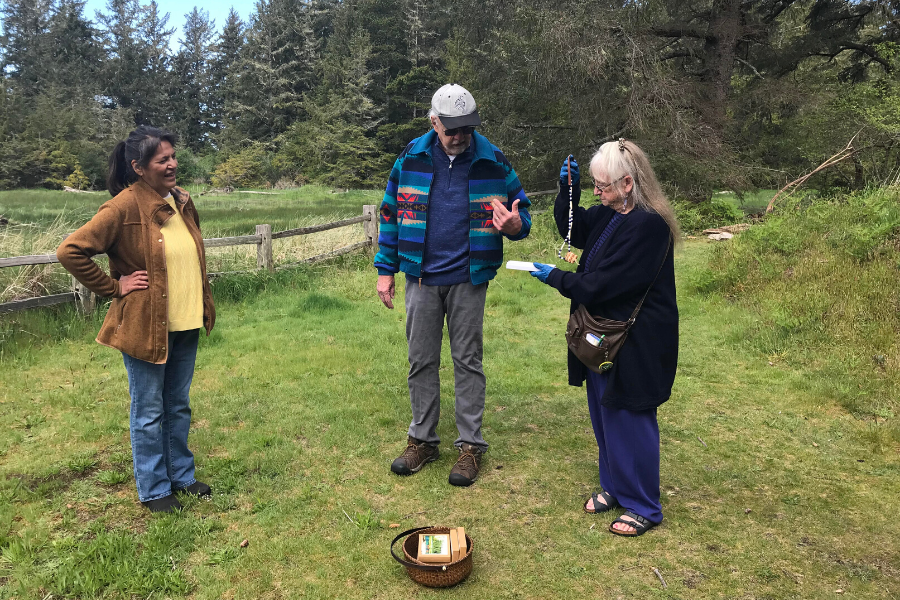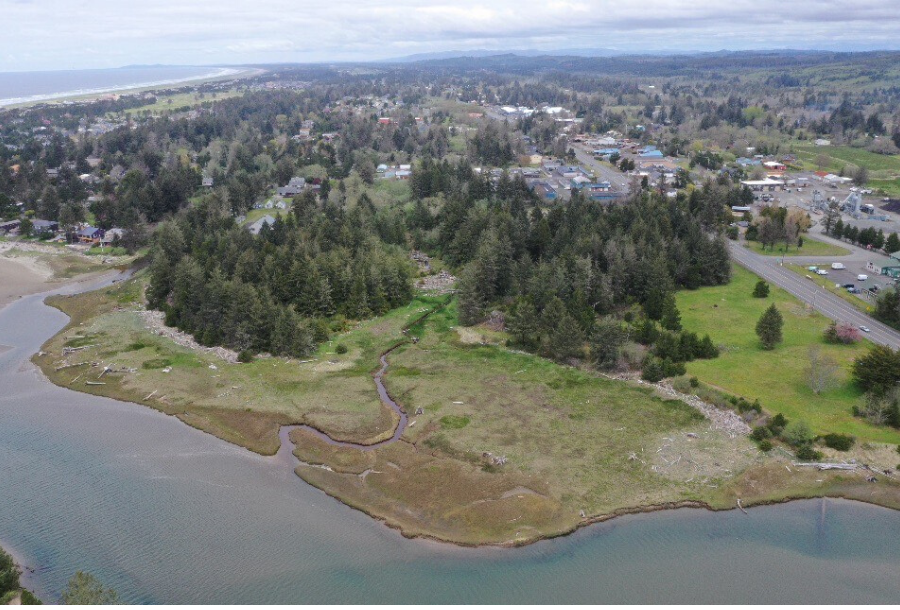
On May 5, 2020, North Coast Land Conservancy transferred ownership of historical tribal lands at Neawanna Point Habitat Reserve—18.6 acres of saltmarsh and Sitka spruce forest on the Necanicum Estuary at the north end of Seaside—to the Clatsop-Nehalem Confederated Tribes. Known to the Clatsop people as Ne-ah-coxie, or “place of little pines,” the property is the first the tribes have owned since losing their lands due to non-native settlement more than 200 years ago.
(Photo: Master carver Guy Capoeman skippering “Dragonfly,” the Clatsop-Nehalem Confederated Tribes’ cedar dugout canoe, past the Ne-ah-coxie village site in the Necanicum estuary, along with paddlers and tribal members Charlotte Basch, Lorraine Basch, and Capoeman’s daughter Ilia Capoeman. Photo courtesy Clatsop-Nehalem Confederated Tribes.)
The village once located on the property had for millennia been home to many Clatsop and Nehalem people until diseases carried by early explorers and fur trappers decimated the native population on the North Coast and arriving white settlers began staking claim to tribal lands in the 19th century.
Federal recognition of the Clatsop and Nehalem tribes was terminated by Congress in 1954. The tribe is now organized as a 501(c)(3) nonprofit organization. NCLC has been in conversation with tribal members for about three years, exploring options for how the Conservancy might help them acquire property in their traditional homelands.
“This was never really North Coast Land Conservancy’s land,” said Executive Director Katie Voelke of the site at the mouth of Neacoxie Creek. “We are glad to have been the caretakers and to now be facilitating the return of this land to its people. It’s an honor to participate in this moment of rebirth and of healing.”
NCLC acquired 20 acres at Neawanna Point in 1998 after a proposed condominium development had plunged the property into controversy. The Conservancy had spent many years exploring options that would allow for key parts of this sensitive ecosystem to be preserved. NCLC later transferred ownership of 1.4 acres fronting US Highway 101 to the City of Seaside to provide a public wayside at this northern gateway to the community. This parcel remains in city ownership.

Photo: Roberta Basch (left), Dick Basch, and Diane Collier at Ne-ah-coxie on May 5, after closing on the property transfer.
“We look forward to walking in the footsteps of our ancestors as we cherish and care for the land,” said A. Diane Collier, tribal chairwoman and descendant of Clatsop Chief Tostum, signer of the 1851 Tansy Point Treaty that was never ratified by the US Senate.
The site has special significance to the Clatsop people, as detailed by Dick and Roberta Basch in “The Ceremony at Ne-ah-coxie,” an essay that appears in the 2007 anthology Lewis and Clark through Indian Eyes. Members of the tribes have held ceremonies and continue to gather at the site as they have historically. Tribal Council Vice Chairman Dick Basch is descended from Celiast, a daughter of Coboway, chief of the Clatsop people at the time of the Lewis and Clark Expedition’s winter-long stay at the mouth of the Columbia River in 1805–06.
Restrictions on the deed prohibit most types of development on the property, though the tribes plan to build a traditional longhouse for their own ceremonial use and to share elements of their culture with the public. NCLC will continue to partner with the tribes in the on-going stewardship of the land.

Photo: The Ne-ah-coxie village site is at the mouth of Neacoxie Creek, on the Necanicum Estuary in north Seaside.
Comments